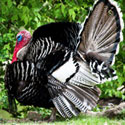
A picture-perfect Pilgrim-era turkey, the Narragansett was developed by early settlers as a cross between Norfolk Black turkeys brought from Europe and local wild turkeys. Having its origins in Rhode Island, the turkey was named after the state’s Narragansett Bay. It was once a common feature in farmyards, but eventually lost favor to more cost-effective industrially developed broad-breasted turkeys.
Today, however, the Narragansett is making a comeback in a big way, especially since Slow Food USA placed this heritage turkey in its Ark of Taste, a catalog of more than 200 delicious and distinctive foods that are potentially on the way to extinction. Slow Food included the Narragansett turkey because of its superior flavor.
Other attributes make Narragansett turkeys ideal for backyards and farmsteads. They are healthy, hardy, and active foragers, able to glean much of their diet from insects and grass. They mature early, have good brooding instincts, and are able to mate naturally.
Mature toms weigh about 28 pounds, hens weigh 16 pounds. At the best weight for harvest, young toms weigh 23 pounds, while hens weigh 14 pounds. The hens lay nice large eggs with ivory to medium brown speckled shells.
The Livestock Conservancy places Narragansett turkeys on its “watch” list, meaning the organization identifies fewer than 2,500 individuals in the United States and fewer than 10,000 estimated worldwide. Although interest in the Narragansett for commercial production wasn’t renewed until the early 21st century, Cackle Hatchery has been ahead of the curve by breeding a pure strain of Narragansett turkeys since 1976.
Enjoying Narragansetts in your own yard helps both to preserve genetic diversity and to protect these beautiful but endangered turkeys from extinction. By choosing to raise Narragansetts for your table, you cast your vote in favor of locally-produced healthful meals. Besides, with their calm disposition and stunning black, gray, tan and white plumage, Narragansett turkeys make an awesome addition to the poultry yard.
And that’s today’s news from the Cackle Coop.
Gail Damerow is editor and principal author of Backyard Homestead Guide to Raising Farm Animals.


Thanks Gail!